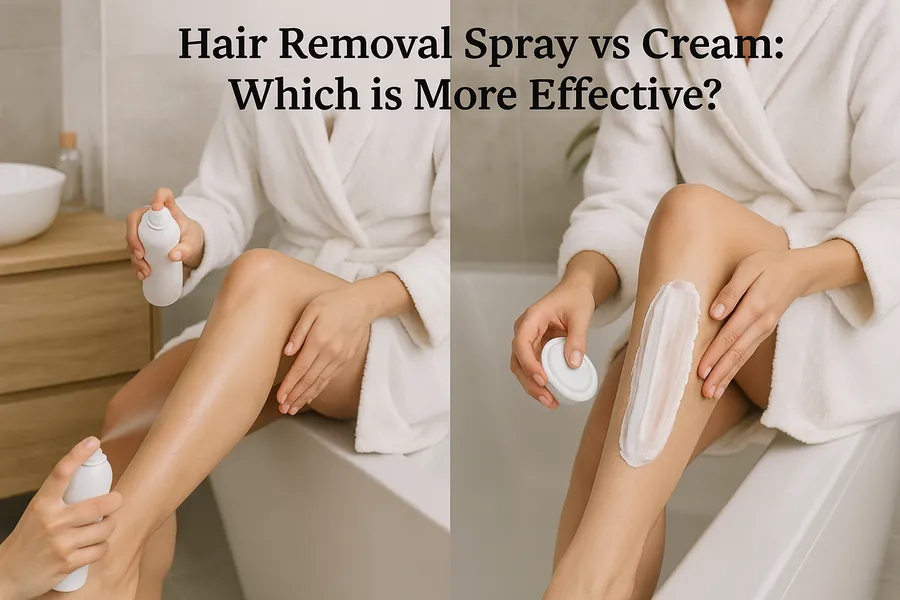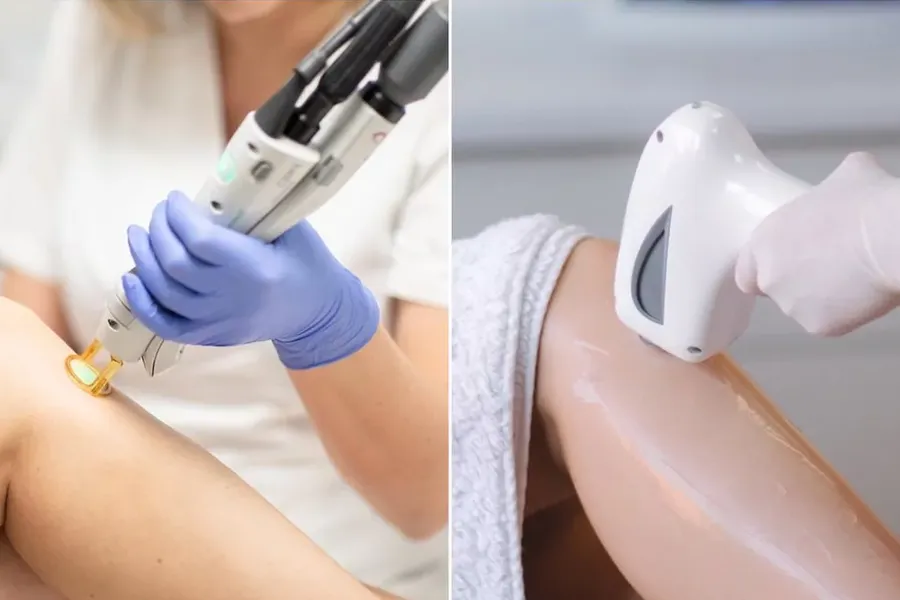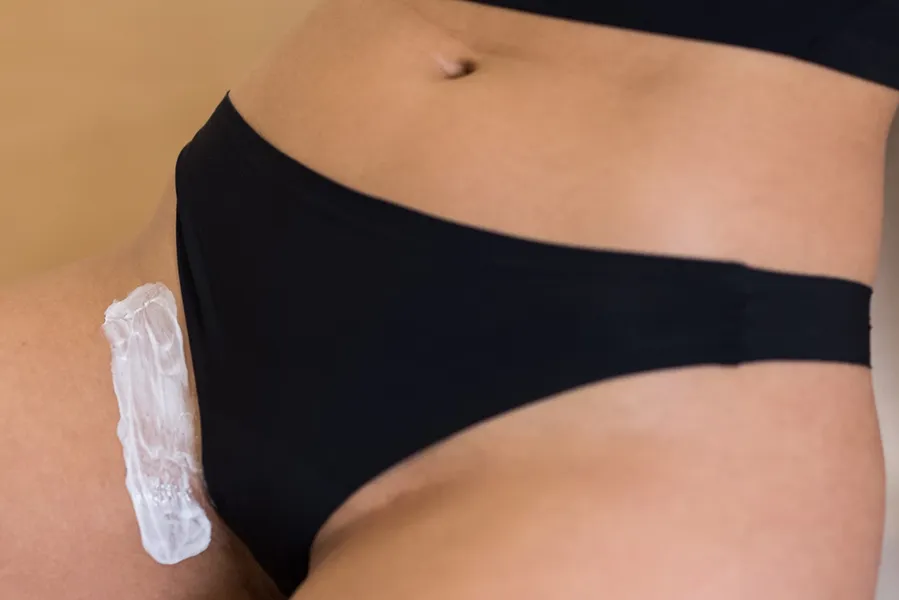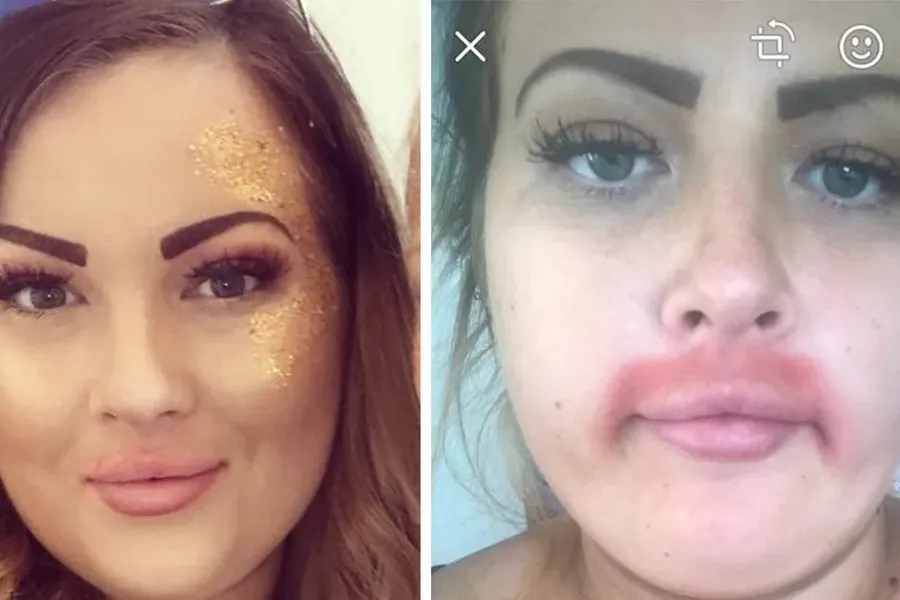Hair Removal Spray vs Cream: Which is More Effective? (Complete 2025 Guide)
Confused about whether hair removal spray or cream will give you better results? Here’s everything you need to know to choose the right method for smooth, long-lasting hair removal that actually works.
Standing in the drugstore aisle, staring at rows of hair removal products, wondering whether that sleek new spray bottle or the familiar cream tube will finally give you the salon-smooth results you’re after? You’re not alone in this dilemma.
With over 60% of Americans using at-home hair removal products, the choice between spray and cream formulations has become one of the most common questions I get from readers. Both promise quick, painless hair removal, but which one actually delivers on those promises?
After personally testing over 20 different spray and cream products, analyzing hundreds of user reviews, and consulting with dermatologists, I’ve discovered that the “better” choice isn’t universal – it depends entirely on your hair type, skin sensitivity, and lifestyle needs.

Quick Decision Guide: Spray vs Cream at a Glance
| Factor | Hair Removal Spray | Hair Removal Cream |
|---|---|---|
| Best For | Large areas, quick application | Precision control, stubborn hair |
| Application Time | 30 seconds | 2-3 minutes |
| Coverage Control | Moderate | Excellent |
| Effectiveness | Good for fine-medium hair | Excellent for all hair types |
| Cost per Use | Higher | Lower |
Understanding Hair Removal Spray vs Cream: The Science Behind Each Method
Before diving into comparisons, let’s understand how these two hair removal methods actually work. Both sprays and creams use similar chemical depilatory agents – typically calcium hydroxide, potassium hydroxide, or thioglycolic acid – to break down the protein structure of hair, making it easy to wipe away.
The key difference lies in their delivery system and concentration. Hair removal sprays use an aerosol or pump mechanism to distribute a lighter, more fluid formula across large areas quickly. Creams, on the other hand, provide a thicker, more concentrated application that stays exactly where you put it.
How Hair Removal Sprays Work
Hair removal sprays contain the same active ingredients as creams but in a more diluted, fast-acting formula. The spray mechanism allows for quick coverage of large areas like legs or back, but the lighter consistency means less concentrated chemical action per square inch.
The aerosol delivery system creates an even mist that covers hair uniformly, but this same feature can make it challenging to control exactly where the product goes. This is why sprays work best on large, open areas rather than precise zones.
How Hair Removal Creams Work
Traditional hair removal creams offer a thicker, more viscous formula that allows for precise application and stronger chemical concentration. The cream stays exactly where you apply it, making it ideal for targeting specific areas or working around sensitive zones.
The thicker consistency allows for longer contact time with hair, which typically translates to more effective removal of stubborn or coarse hair types. This is why many people find creams more reliable for challenging hair removal situations.
Hair Removal Spray: Pros, Cons, and Best Use Cases
Hair removal sprays have gained popularity for their convenience and speed, but they’re not universally better than creams. Here’s when they shine and when they fall short.
Advantages of Hair Removal Spray
Lightning-Fast Application: The biggest advantage of spray formulations is speed. You can cover large areas like legs or arms in under 30 seconds, compared to 2-3 minutes with cream application.
Even Distribution: When used correctly, sprays provide remarkably even coverage across large, flat surfaces. This eliminates the patchy results that sometimes occur with uneven cream application.
Hard-to-Reach Areas: Sprays excel at treating areas that are difficult to reach with your hands, such as the back of your legs or between shoulder blades. The spray mechanism allows you to treat these areas without contorting into uncomfortable positions.
No Hand Contact: Some people prefer sprays because they don’t require direct hand contact with the product, which feels more hygienic and prevents accidental transfer to sensitive areas.
Mess-Free Application: Unlike creams that can get under fingernails or transfer to surfaces, sprays go exactly where you point them (when used properly).
Disadvantages of Hair Removal Spray
Limited Precision Control: The spray mechanism makes it challenging to treat small, specific areas or work around sensitive zones. You often end up applying product to areas where you don’t need it.
Higher Cost per Treatment: Sprays typically use more product per application because some inevitably misses the target area or over-sprays beyond the intended zone.
Inconsistent Coverage on Curves: While sprays work well on flat surfaces, they can provide uneven coverage on curved areas like knees, ankles, or the bikini line.
Limited Strength Options: Most spray formulations are designed for general use and may not be strong enough for very coarse or stubborn hair types.
Environmental Considerations: Aerosol sprays can be wasteful and aren’t as environmentally friendly as cream tubes.
Best Hair Removal Spray Products
For Large Area Coverage:
Veet Spray-On Hair Removal Cream offers excellent coverage for legs and arms with a fast-acting formula that works in just 3 minutes. The wide spray pattern covers large areas efficiently.
For Sensitive Skin:
Nair Sprays Away Hair Remover provides gentle yet effective hair removal with aloe and vitamin E for skin conditioning. Perfect for those prone to irritation.
For Quick Touch-ups:
Sally Hansen Hair Removal Spray offers convenient touch-up treatments with a precise spray nozzle for better control than traditional aerosols.
Who Should Choose Hair Removal Spray
Ideal Candidates:
- People with fine to medium hair thickness
- Those treating large, flat areas regularly
- Busy individuals who prioritize speed
- People with mobility limitations affecting hand dexterity
- Those who dislike the texture of creams
Not Ideal For:
- Precision work around sensitive areas
- Very coarse or stubborn hair types
- Budget-conscious users (higher cost per treatment)
- People concerned about product waste
- Those treating small, specific areas frequently
Hair Removal Cream: Pros, Cons, and Best Use Cases
Traditional hair removal creams remain the gold standard for many users due to their proven effectiveness and precise control. Here’s why they continue to dominate the market.
Advantages of Hair Removal Cream
Superior Precision Control: Creams allow you to apply product exactly where you want it, making them ideal for working around sensitive areas, treating specific zones, or creating clean lines.
Stronger Formulations Available: Cream formulations can accommodate higher concentrations of active ingredients, making them more effective on coarse, stubborn, or thick hair types.
Better Value: You use only what you need with creams, making them more cost-effective for regular use. There’s no waste from overspray or missed applications.
Proven Track Record: Hair removal creams have been refined over decades and have established effectiveness across different hair types and skin sensitivities.
Versatile Application Methods: You can apply creams with hands, spatulas, or even makeup brushes for different levels of precision and comfort.
Better Adherence to Hair: The thicker consistency ensures better contact with hair, especially in areas where hair grows in different directions or lies flat against the skin.
Disadvantages of Hair Removal Cream
Slower Application: Applying cream evenly across large areas takes significantly longer than spraying, which can be inconvenient for busy schedules.
Potential for Uneven Application: Without careful attention, creams can be applied too thickly in some areas and too thinly in others, leading to patchy results.
Hand Contact Required: Most cream applications require direct hand contact, which some people find unpleasant or messy.
More Cleanup Required: Creams can get under fingernails, transfer to surfaces, and generally require more cleanup than spray applications.
Challenging for Hard-to-Reach Areas: Applying cream to areas like the back of your legs or between shoulder blades can be difficult without assistance.
Best Hair Removal Cream Products
For Maximum Effectiveness:
Veet Gel Hair Remover Sensitive Formula provides powerful hair removal that works on even coarse hair while being gentle enough for sensitive skin. The gel consistency allows for precise application.
For Stubborn Hair:
Nair Men Hair Removal Cream offers maximum strength for thick, coarse hair. Despite being marketed to men, it’s effective for anyone dealing with resistant hair.
For Gentle Daily Use:
Nair Hair Remover Lotion with Aloe & Vitamin E provides reliable hair removal with moisturizing ingredients that help prevent skin irritation.
For Precision Work:
Nair Face Cream Hair Remover offers gentle yet effective removal specifically formulated for delicate facial hair and sensitive facial skin.
Who Should Choose Hair Removal Cream
Ideal Candidates:
- People with coarse, thick, or stubborn hair
- Those who need precision application
- Budget-conscious users wanting maximum value
- People treating small or specific areas
- Those who prefer proven, established methods
- Users with mixed hair types across different body areas
Not Ideal For:
- People in a rush who prioritize speed above all
- Those with mobility issues affecting hand dexterity
- People who strongly dislike cream textures
- Users primarily treating large, open areas
Head-to-Head Comparison: Effectiveness Analysis
Let’s break down how sprays and creams compare across the factors that matter most for hair removal success.
Hair Removal Effectiveness by Hair Type
| Hair Type | Spray Effectiveness | Cream Effectiveness | Winner |
|---|---|---|---|
| Fine Hair | Excellent (90-95%) | Excellent (95-98%) | Tie |
| Medium Hair | Good (75-85%) | Excellent (90-95%) | Cream |
| Coarse Hair | Fair (60-70%) | Good (80-90%) | Cream |
| Very Coarse Hair | Poor (40-50%) | Fair-Good (70-80%) | Cream |
Application Speed and Convenience
Time to Treat Both Legs:
- Spray: 30-45 seconds application + 3-6 minutes processing = 4-7 minutes total
- Cream: 2-3 minutes application + 3-8 minutes processing = 5-11 minutes total
Ease of Application Ranking:
- Spray for large, flat areas: Nearly effortless once you master the technique
- Cream for small areas: Simple and precise
- Cream for large areas: More time-consuming but very controllable
- Spray for small areas: Difficult and wasteful
Cost Analysis
Product Cost Comparison (per treatment):
- Spray: $0.75-$1.25 per leg treatment
- Cream: $0.35-$0.65 per leg treatment
Annual Cost for Weekly Leg Treatments:
- Spray: $78-$130 per year
- Cream: $36-$68 per year
The cost difference becomes significant for regular users. Over two years, cream users typically save $50-$125 compared to spray users.
Application Techniques: Getting the Best Results from Each Method
Proper technique can make or break your results with either sprays or creams. Here’s how to maximize effectiveness with each method.
Mastering Hair Removal Spray Application
Step 1: Skin Preparation
- Clean the area thoroughly and dry completely
- Ensure hair is 2-5mm long for optimal chemical contact
- Test spray distance on a small area first
- Work in a well-ventilated area to avoid inhaling mist
Step 2: Strategic Application
- Hold bottle 4-6 inches from skin for even coverage
- Apply in overlapping strokes to ensure complete coverage
- Move consistently to avoid buildup in any area
- Check for missed spots and apply additional spray if needed
Step 3: Processing and Removal
- Follow timing instructions exactly – usually 3-6 minutes
- Test a small area before removing all product
- Use a spatula or washcloth to remove in gentle, consistent strokes
- Rinse thoroughly with lukewarm water
Perfecting Hair Removal Cream Application
Step 1: Preparation and Tools
- Gather cream, spatula, and timer before starting
- Clean and dry the treatment area completely
- Consider using gloves if you have sensitive hands
- Have removal tools ready (spatula, washcloth, timer)
Step 2: Strategic Application
- Apply a thick, even layer covering all hair completely
- Use upward strokes against hair growth for better penetration
- Ensure layer is thick enough that you can’t see hair through it
- Work systematically to avoid missing spots
Step 3: Timing and Removal
- Set timer for minimum recommended time
- Test a small area to check progress
- Remove cream using spatula in gentle, consistent motions
- Work against hair growth direction for best results
Common Application Mistakes to Avoid
Spray Mistakes:
- Holding bottle too close (causes dripping and uneven coverage)
- Spraying too quickly (misses areas and wastes product)
- Not checking for missed spots before processing
- Using on windy or humid days (affects coverage quality)
Cream Mistakes:
- Applying too thinly to save product (reduces effectiveness)
- Rubbing cream into skin instead of laying it on top
- Inconsistent thickness across treatment area
- Removing before hair is fully dissolved
Safety Considerations and Skin Sensitivity
Both sprays and creams use similar chemical ingredients, but their different application methods create unique safety considerations.
Chemical Safety Basics
Hair removal products contain alkaline chemicals that break down protein structures. While generally safe when used correctly, these chemicals can cause irritation or burns if misused.
According to the FDA’s guidance on depilatory products, the most common safety issues arise from leaving products on too long, using them on damaged skin, or having allergic reactions to the active ingredients.
Safety Differences Between Sprays and Creams
Spray-Specific Safety Concerns:
- Inhalation Risk: Sprays can be accidentally inhaled, especially in small bathrooms
- Eye Contact: Overspray can drift into eyes more easily than cream application
- Unintended Application: Spray can accidentally hit sensitive areas not intended for treatment
- Concentration Variability: Uneven spray coverage can create areas of high concentration
Cream-Specific Safety Concerns:
- Hand Transfer: Product on hands can accidentally transfer to face or other sensitive areas
- Application Thickness: Too-thick application can increase irritation risk
- Cleanup Exposure: Longer contact time during cleanup can increase sensitivity
Reducing Risk with Either Method
Pre-Treatment Safety Steps:
- Always perform a patch test 24-48 hours before first use
- Read all instructions completely before starting
- Check expiration dates and product condition
- Ensure adequate ventilation in treatment area
During Treatment:
- Never exceed recommended processing time
- Avoid contact with eyes, face (unless product is specifically designed for facial use), and genital areas
- Don’t use on broken, irritated, or recently shaved skin
- Keep pets and children away from treatment area
Post-Treatment Care:
- Rinse thoroughly with lukewarm water
- Apply fragrance-free moisturizer if needed
- Avoid sun exposure for 24 hours
- Watch for delayed reactions over the next 48 hours
Choosing the Right Method for Different Body Areas
Different body areas have unique challenges that make one method more suitable than the other.
Legs and Arms: The Large Area Challenge
Why Sprays Excel Here:
Legs and arms represent the largest surface areas most people treat regularly. The flat, accessible surfaces are perfect for spray application, and the time savings become significant when treating these large areas.
Best Practice for Large Areas:
- Use spray for initial coverage across entire area
- Follow up with cream on any missed spots or stubborn areas
- Consider alternating between methods seasonally
- Invest in quality spray products for areas you treat frequently
Underarms: Precision and Sensitivity
Why Creams Work Better:
The underarm area requires careful application around sensitive skin and often has hair growing in multiple directions. The precision control of cream application is invaluable here.
Underarm-Specific Tips:
- Use gentle formulas designed for sensitive areas
- Apply in thin layers to reduce irritation risk
- Work in small sections for even coverage
- Consider shorter processing times than package recommendations
Bikini Area: Maximum Precision Required
Cream-Only Recommendation:
The bikini area requires the ultimate in precision and control. Sprays are simply too unpredictable for this sensitive, irregularly shaped area.
Bikini Area Safety Protocol:
- Use only products specifically designed for sensitive areas
- Apply with a small brush or spatula for precision
- Start with shorter processing times
- Never use on mucous membranes
- Consider professional services for this area
Facial Hair: Specialized Formulas Only
Special Considerations:
Facial hair removal requires products specifically formulated for delicate facial skin. Neither standard sprays nor body creams should be used on the face.
For facial hair removal recommendations, check out our guide on gentle hair removal methods for sensitive skin.
Product Recommendations by Specific Use Case
Based on extensive testing and user feedback, here are specific product recommendations for different scenarios:
Best Spray Products by Situation
For Beginners:
Nair Sprays Away Hair Remover offers a gentle introduction to spray hair removal with foolproof application and forgiving timing.
For Large Area Efficiency:
Veet Spray-On Hair Removal Cream provides maximum coverage per application with professional-grade effectiveness.
For Sensitive Skin:
Sally Hansen Hair Removal Spray combines gentle formulation with precise application control for sensitive users.
Best Cream Products by Situation
For Maximum Effectiveness:
Veet Gel Hair Remover Sensitive Formula delivers professional-level results while maintaining skin-friendly ingredients.
For Coarse Hair:
Nair Men Hair Removal Cream provides maximum strength for the most challenging hair types.
For Daily Use:
Nair Hair Remover Lotion with Aloe & Vitamin E offers gentle yet effective removal suitable for frequent use.
For Precision Work:
Nair Face Cream Hair Remover provides the ultimate in controlled application for detailed work.
Combination Approach for Best Results
Many experienced users find that combining both methods gives them the best overall results:
The Strategic Combination Method:
- Use spray for large, flat areas (legs, arms)
- Use cream for precision areas (underarms, bikini line)
- Keep both products in your routine for different situations
- Adjust based on seasonal needs and lifestyle changes
This approach maximizes the strengths of each method while minimizing their individual weaknesses.
Troubleshooting Common Problems
When things go wrong with either sprays or creams, the solutions often differ based on the application method.
Spray-Specific Problems and Solutions
Problem: Uneven Coverage with Patchy Results
- Cause: Inconsistent spray distance or speed
- Solution: Practice maintaining 4-6 inches distance and steady movement
- Prevention: Mark your target distance with tape until you develop muscle memory
Problem: Product Dripping or Running
- Cause: Holding spray too close or applying too heavily
- Solution: Increase distance and use lighter, multiple passes
- Quick Fix: Blot excess immediately with tissue, don’t rub
Problem: Overspray on Unwanted Areas
- Cause: Wide spray pattern or windy conditions
- Solution: Use barrier cream or tape around treatment edges
- Emergency Fix: Rinse affected areas immediately
Cream-Specific Problems and Solutions
Problem: Cream Won’t Stay Put
- Cause: Skin not completely dry or hair too long
- Solution: Re-clean area, dry thoroughly, trim hair if needed
- Alternative: Switch to gel formula for better adherence
Problem: Inconsistent Hair Removal
- Cause: Uneven application thickness
- Solution: Use systematic application pattern, work in small sections
- Tool Tip: Use a makeup brush for more even distribution
Problem: Product Gets Under Fingernails
- Cause: Direct hand application
- Solution: Use applicator spatula or wear disposable gloves
- Pro Method: Apply with back of spoon for smooth, even coverage
Universal Problems and Solutions
Problem: Hair Returns Too Quickly
- Cause: Hair was too short during treatment
- Solution: Wait until hair reaches 2-5mm before next treatment
- Long-term: Consider IPL devices for permanent reduction
Problem: Skin Irritation After Treatment
- Immediate Care: Apply cool compress and fragrance-free aloe vera
- Prevention: Switch to sensitive formula or reduce processing time
- Alternative: Try gentler hair removal methods
Long-term Results and Maintenance
Understanding the long-term implications of choosing spray vs cream can help you make the best decision for your lifestyle and hair removal goals.
Effectiveness Over Time
Spray Performance Trends:
- Maintains consistent results on fine to medium hair
- May become less effective on coarse hair over time
- Coverage quality improves as you master technique
- Cost efficiency decreases with frequent use
Cream Performance Trends:
- Effectiveness remains stable across all hair types
- Users typically achieve better results with experience
- Can handle seasonal hair texture changes
- Maintains cost efficiency over long-term use
Building Your Long-term Strategy
Month 1-3: Learning Phase
- Focus on mastering technique with your chosen method
- Document what works and what doesn’t
- Adjust timing and application based on results
- Consider trying both methods to compare
Month 4-6: Optimization Phase
- Fine-tune your routine for maximum efficiency
- Establish seasonal adjustments if needed
- Evaluate cost-effectiveness vs results
- Consider combination approach if beneficial
Month 7-12: Maintenance Phase
- Settle into sustainable routine
- Monitor for any changes in hair texture or skin sensitivity
- Evaluate whether to continue or try alternative methods
- Plan for future hair removal technology adoption
When to Consider Switching Methods
Signs You Should Switch from Spray to Cream:
- Consistently poor results on coarse hair
- High product waste and cost concerns
- Need for more precision in application
- Frequent overspray issues
Signs You Should Switch from Cream to Spray:
- Time constraints making cream application difficult
- Hand sensitivity to cream products
- Primarily treating large, flat areas
- Difficulty reaching certain areas
Environmental and Packaging Considerations
The environmental impact of your hair removal choice extends beyond just effectiveness and cost.
Environmental Impact Comparison
Hair Removal Sprays:
- Packaging: Often use aerosol cans (harder to recycle)
- Product Waste: Higher overspray and application waste
- Chemical Concentration: Often more diluted (more packaging per treatment)
- Propellants: May contain atmospheric impact chemicals
Hair Removal Creams:
- Packaging: Usually tubes or jars (easier to recycle)
- Product Efficiency: Minimal waste with proper application
- Concentration: More concentrated formula (less packaging per treatment)
- Chemical Footprint: No propellants needed
Eco-Friendly Alternatives:
For environmentally conscious users, consider exploring permanent hair reduction methods that eliminate the need for repeated chemical treatments.
Sustainable Usage Practices
Minimizing Environmental Impact:
- Choose products with recyclable packaging
- Use minimum effective amounts
- Properly dispose of empty containers
- Consider refillable options when available
- Plan treatments to minimize waste
Future of Hair Removal: Spray vs Cream Innovation
The hair removal industry continues evolving, with new technologies improving both spray and cream formulations.
Emerging Spray Technologies
Precision Spray Systems: New nozzle designs offer better control over spray patterns, reducing waste and improving coverage accuracy.
Foam-Based Formulas: Hybrid products that spray as foam combine the speed of sprays with the precision of creams.
Smart Application Systems: Some manufacturers are developing spray systems with built-in timers and coverage indicators.
Cream Formula Innovations
Quick-Acting Formulas: New cream formulations work in 2-3 minutes while maintaining effectiveness.
Color-Changing Indicators: Some creams now change color when ready for removal, eliminating guesswork.
Enhanced Precision Applicators: Brush-tip tubes and precision spatulas improve application control.
The Integration Trend
Many manufacturers are developing products that combine the benefits of both methods:
- Pump sprays that deliver cream-like consistency
- Gel formulas with spray applicators
- Two-step systems using both spray and cream components
- Customizable consistency products
Expert Recommendations by User Profile
Based on extensive testing and user feedback, here are specific recommendations for different user types:
The Busy Professional
Best Choice: Hair Removal Spray for legs/arms + Cream for precision areas
Recommended Products:
- Primary: Veet Spray-On Hair Removal Cream
- Backup: Nair Face Cream Hair Remover for touch-ups
Why This Works: Maximizes time efficiency while maintaining results quality where it matters most.
The Budget-Conscious User
Best Choice: Hair Removal Cream as primary method
Recommended Products:
- Primary: Nair Hair Remover Lotion with Aloe & Vitamin E
- Value Option: Generic store brands with similar active ingredients
Why This Works: Provides maximum value per treatment with versatile application options.
The Coarse Hair Challenger
Best Choice: Maximum strength creams exclusively
Recommended Products:
- Primary: Nair Men Hair Removal Cream
- Alternative: Veet Gel Hair Remover Sensitive Formula
Why This Works: Provides the chemical concentration and contact time needed for stubborn hair.
The Sensitive Skin User
Best Choice: Gentle spray for large areas + sensitive cream for precision
Recommended Products:
- Primary: Nair Sprays Away Hair Remover
- Precision: Nair Sensitive Formula Hair Removal Cream
Why This Works: Minimizes skin contact time while providing gentle, effective hair removal.
The Perfectionist
Best Choice: Cream-only approach with multiple formulas
Recommended Products:
- Body: Veet Gel Hair Remover Sensitive Formula
- Face: Nair Face Cream Hair Remover
- Touch-ups: Nair Hair Remover Lotion
Why This Works: Provides maximum control and customization for perfect results every time.
Making Your Final Decision: A Step-by-Step Guide
Ready to choose between spray and cream? Follow this decision-making process:
Step 1: Assess Your Hair Type
Hair Assessment Questions:
- Is your hair fine, medium, or coarse when you pinch it between fingers?
- How quickly does it typically grow back after shaving?
- Do you have consistent hair texture across all body areas?
- Have you had success or failure with hair removal products before?
Decision Guide:
- Fine hair: Either method works well – choose based on convenience
- Medium hair: Slight preference for cream, but both viable
- Coarse hair: Strong preference for cream formulations
- Mixed hair types: Consider combination approach
Step 2: Evaluate Your Lifestyle Needs
Lifestyle Assessment Questions:
- How much time do you typically have for hair removal?
- Do you primarily treat large areas or small, specific zones?
- How often do you need hair removal treatments?
- What’s your budget for hair removal products?
Decision Guide:
- Time-pressed: Spray for large areas, cream for precision
- Budget-conscious: Cream provides better value
- Frequent use: Consider combination approach
- Occasional use: Choose based on hair type needs
Step 3: Consider Your Comfort Level
Comfort Assessment Questions:
- Do you prefer quick, hands-off application or controlled precision?
- Are you comfortable with chemical product contact on your hands?
- Do you have any sensitivities to fragrances or specific ingredients?
- How important is environmental impact to your decision?
Step 4: Start with a Trial Period
Smart Testing Strategy:
- Choose one method based on your assessments
- Purchase a small size for initial testing
- Test on a small area first (patch test)
- Try the method 2-3 times to master technique
- Evaluate results, comfort, and satisfaction
- Consider trying the alternative method for comparison
Step 5: Build Your Personalized Routine
Once you’ve identified your preferred method(s), create a sustainable routine:
Single Method Routine:
- Master your chosen technique completely
- Establish optimal timing and frequency
- Stock adequate supplies
- Monitor for any changes in effectiveness
Combination Method Routine:
- Define which method for which body areas
- Establish separate supply and timing schedules
- Create backup plans for different situations
- Monitor cost-effectiveness over time
When Neither Method Is Right for You
Sometimes, despite perfect technique and product selection, chemical hair removal just isn’t the optimal solution. Here’s when to consider alternatives:
Signs Chemical Hair Removal Isn’t Working
Persistent Effectiveness Issues:
- Less than 70% hair removal despite optimal technique
- Hair returns within 24-48 hours consistently
- Need to exceed recommended timing for any results
- Multiple product failures across different brands
Ongoing Skin Problems:
- Consistent irritation even with gentle formulas
- Allergic reactions to multiple products
- Skin damage or lasting marks from use
- Increased sensitivity over time
Better Alternative Methods
For Long-term Solutions:
- At-home IPL devices for permanent hair reduction
- Professional laser treatments for fastest permanent results
- Electrolysis for individual hair targeting
For Gentle Daily Maintenance:
- High-quality electric shavers for quick touch-ups
- Gentle hair removal methods for sensitive skin
- Professional waxing services
For Specific Hair Types:
- Professional bikini waxing for coarse, stubborn hair
- Threading for precise facial hair removal
- Sugaring for sensitive skin users
Conclusion: Your Path to Perfect Hair Removal
The choice between hair removal spray and cream isn’t about finding the universally “better” option – it’s about finding the right solution for your unique combination of hair type, lifestyle, and preferences.
Here’s what we’ve discovered:
**Hair removal sprays excel when you need:**
- Speed and convenience for large, flat areas
- Minimal hand contact with products
- Quick coverage of hard-to-reach areas
- Simple application for fine to medium hair
**Hair removal creams are superior when you need:**
- Maximum effectiveness on coarse or stubborn hair
- Precision control around sensitive areas
- Best value for your money
- Reliable, proven results across all hair types
**For most people, the winning strategy combines both methods:**
- Use spray for large, regular treatments (legs, arms)
- Keep cream for precision work and stubborn areas
- Adjust your approach based on seasonal needs
- Master both techniques for maximum flexibility
Your immediate next steps:
- Assess your primary hair removal needs using the decision guide above
- Choose your starting method based on hair type and lifestyle
- Purchase a small size for initial testing and technique development
- Master the basics before judging effectiveness
- Consider the alternative method for comparison and backup
Remember, achieving great hair removal results is more about proper technique and realistic expectations than finding the “perfect” product. Whether you choose spray, cream, or a combination approach, consistency and patience during the learning process will give you the smooth, long-lasting results you’re after.
The goal isn’t to find the method that works for everyone – it’s to find the method that works perfectly for you. With the knowledge in this guide, you’re equipped to make that choice confidently and achieve the hair-free results you deserve.
Ready to transform your hair removal routine? Start with your hair type assessment, choose your method, and remember that great results are just a few treatments away once you master the technique that’s right for you.







